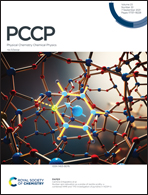On the structure–property relationships of (Al, Ga, In)-doped spinel cobalt ferrite compounds: a combined experimental and DFT study†
Abstract
We report a combined experimental and theoretical study of pure and doped cobalt ferrite where 25% of Fe3+ ions were replaced by Al3+, Ga3+, and In3+ ions, respectively, i.e., CoFe1.5X0.5O4 (X = Al, Ga, and In). The ferrite compositions were successfully synthesized using the solid-state reaction method. The X-ray powder diffraction method established that all ferrite samples had a spinel unit cell structure with the Fd![[3 with combining macron]](https://www.rsc.org/images/entities/char_0033_0304.gif) m (No. 227) space group. The lattice constants of ferrites increased from 8.382 Å (for undoped CoFe2O4) to 8.520 Å (for In-doped cobalt ferrite) in direct relation to the dopant ion size. The magnetic properties were obtained at 4.3 K and 300 K. At 4.3 K, the In-doped CoFe2O4 showed the highest saturation magnetic moment of 4.68 μB f.u.−1, while Al-doped CoFe2O4 showed the smallest value of 2.72 μB f.u.−1. The Fe3+ distribution among the spinel tetrahedral and octahedral sites was determined from the Mössbauer spectra. From ultraviolet-visible diffuse reflectance spectroscopy the direct optical bandgaps were determined, which have values between 1.20 eV and 1.28 eV for these ferrites. The ferrite compositions were also studied theoretically using plane-wave density functional theory using the CASTEP code where it was revealed that arrangements of the non-magnetic cations at the tetrahedral and octahedral sites strongly influence the electronic structure, the bandgap value, and the net magnetic moment per formula unit. Light Al3+ ions at the octahedral site give a low value of the net magnetic moment while the heavier Ga3+ and In3+ ions at the tetrahedral sites of the spinel give an enhanced magnetic moment. The magnetic moment values obtained from theoretical calculations match very well with the experimental values. Moreover, the theoretical calculations reveal that there exists a strong p–d hybridization among the oxygen and magnetic ions, which is affected by the non-magnetic dopant ions. The change in hybridization with the non-magnetic ion doping is responsible for the altered magnetic moments of the doped ferrites. Thus, our study provides a comprehensive investigation covering the synthesis and characterization of ferrites along with a good understanding of the phenomenon of how non-magnetic ion doping into spinel ferrites provides a method to tune the electronic and magnetic properties of the spinel ferrite.
m (No. 227) space group. The lattice constants of ferrites increased from 8.382 Å (for undoped CoFe2O4) to 8.520 Å (for In-doped cobalt ferrite) in direct relation to the dopant ion size. The magnetic properties were obtained at 4.3 K and 300 K. At 4.3 K, the In-doped CoFe2O4 showed the highest saturation magnetic moment of 4.68 μB f.u.−1, while Al-doped CoFe2O4 showed the smallest value of 2.72 μB f.u.−1. The Fe3+ distribution among the spinel tetrahedral and octahedral sites was determined from the Mössbauer spectra. From ultraviolet-visible diffuse reflectance spectroscopy the direct optical bandgaps were determined, which have values between 1.20 eV and 1.28 eV for these ferrites. The ferrite compositions were also studied theoretically using plane-wave density functional theory using the CASTEP code where it was revealed that arrangements of the non-magnetic cations at the tetrahedral and octahedral sites strongly influence the electronic structure, the bandgap value, and the net magnetic moment per formula unit. Light Al3+ ions at the octahedral site give a low value of the net magnetic moment while the heavier Ga3+ and In3+ ions at the tetrahedral sites of the spinel give an enhanced magnetic moment. The magnetic moment values obtained from theoretical calculations match very well with the experimental values. Moreover, the theoretical calculations reveal that there exists a strong p–d hybridization among the oxygen and magnetic ions, which is affected by the non-magnetic dopant ions. The change in hybridization with the non-magnetic ion doping is responsible for the altered magnetic moments of the doped ferrites. Thus, our study provides a comprehensive investigation covering the synthesis and characterization of ferrites along with a good understanding of the phenomenon of how non-magnetic ion doping into spinel ferrites provides a method to tune the electronic and magnetic properties of the spinel ferrite.



 Please wait while we load your content...
Please wait while we load your content...